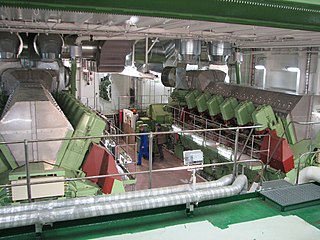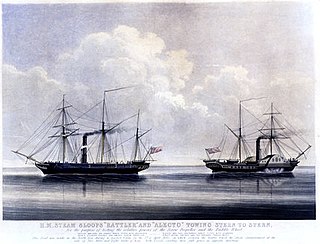Related Research Articles

A propeller is a device with a rotating hub and radiating blades that are set at a pitch to form a helical spiral, that, when rotated, performs an action which is similar to Archimedes' screw. It transforms rotational power into linear thrust by acting upon a working fluid, such as water or air. The rotational motion of the blades is converted into thrust by creating a pressure difference between the two surfaces. A given mass of working fluid is accelerated in one direction and the craft moves in the opposite direction. Propeller dynamics, like those of aircraft wings, can be modelled by Bernoulli's principle and Newton's third law. Most marine propellers are screw propellers with helical blades rotating on a propeller shaft with an approximately horizontal axis.

A steamship, often referred to as a steamer, is a type of steam-powered vessel, typically ocean-faring and seaworthy, that is propelled by one or more steam engines that typically move (turn) propellers or paddlewheels. The first steamships came into practical usage during the early 1800s; however, there were exceptions that came before. Steamships usually use the prefix designations of "PS" for paddle steamer or "SS" for screw steamer. As paddle steamers became less common, "SS" is assumed by many to stand for "steamship". Ships powered by internal combustion engines use a prefix such as "MV" for motor vessel, so it is not correct to use "SS" for most modern vessels.

A steamboat is a boat that is propelled primarily by steam power, typically driving propellers or paddlewheels. Steamboats sometimes use the prefix designation SS, S.S. or S/S or PS ; however, these designations are most often used for steamships.

A paddle steamer is a steamship or steamboat powered by a steam engine that drives paddle wheels to propel the craft through the water. In antiquity, paddle wheelers followed the development of poles, oars and sails, where the first uses were wheelers driven by animals or humans.

Steam frigates, also known as screw frigates and the smaller steam corvettes and steam sloops, were steam-powered warships that were not meant to stand in the line of battle. The first such ships were paddle steamers. Later on the invention of screw propulsion enabled construction of steam-powered versions of the traditional frigates, corvettes, and sloops.
USS Allegheny (1847) — the first United States Navy ship to be so named — was a large iron-hulled steamer that served as an American gunboat in the South Atlantic Ocean as well as in the European area. When the American Civil War occurred, Allegheny served the Union cause honorably, doing her part by supporting the Union Navy — because of her large size and operational condition — as a receiving ship.

Napoléon was a 90-gun ship of the line of the French Navy, and the first purpose-built steam battleship in the world. She is also considered the first true steam battleship, and the first screw battleship ever.

Marine propulsion is the mechanism or system used to generate thrust to move a ship or boat across water. While paddles and sails are still used on some smaller boats, most modern ships are propelled by mechanical systems consisting of an electric motor or engine turning a propeller, or less frequently, in pump-jets, an impeller. Marine engineering is the discipline concerned with the engineering design process of marine propulsion systems.

HMS Rattler was a 9-gun wooden sloop of war of the Royal Navy and the first British warship to adopt a screw propeller powered by a steam engine. She was arguably the first such warship in the world—the sloop USS Princeton was launched after Rattler, but was placed in commission much sooner.

Demologos was the first warship to be propelled by a steam engine. She was a wooden floating battery built to defend New York Harbor from the Royal Navy during the War of 1812. The vessel was designed to a unique pattern by Robert Fulton, and was renamed Fulton after his death. Because of the prompt end of the war, Demologos never saw action, and no other ship like her was built.
The first USS Union was a steamer designed and constructed by the U.S. Navy as an experimental improved version of its current steam-powered ships which were not considered as efficient as they should be.
USS Water Witch (1845) was a steamer designed and constructed by the U.S. Navy with an experimental propulsion system that never quite worked, the Hunter wheel.

The first Missouri, a 10‑gun side‑wheel frigate, one of the first steam warships in the United States Navy, was begun at New York Navy Yard in 1840. She was launched 7 January 1841 and commissioned very early in 1842 with Captain John T. Newton in command.

The roller ship was an unconventional and unsuccessful ship design of the late nineteenth century, which attempted to propel itself by means of large wheels. Only one such vessel was constructed—Ernest Bazin, named for its inventor —which was found to be impractical.
J. and G. Rennie was a British engineering company based in Millwall, London, England. They were involved in manufacture of marine engines, and some complete ships, as well as other diverse onshore engineering projects. An association with railway engines is usually attributed to G. and J. Rennie, which may suggest they used a second company to keep the books separate, and there was also George Rennie & Sons, which is associated with the development and patents of the steam disc engine. All three companies appear to have been in existence at the same time.

SS Archimedes was a steamship built in Britain in 1839. She was the world's first steamship to be driven by a screw propeller.
The revenue cutter George M. Bibb was an iron-hulled steamboat built at Pittsburgh in 1845, named after the then-Secretary of the Treasury George M. Bibb, which served on blockade duty during the war with Mexico in 1846, and was transferred to the U.S. Coast Survey in 1847. Its engines were salvaged for a second Bibb that is sometimes considered to be a rebuild of the George M. Bibb.

A team boat, horse boat, or horse ferry, is a watercraft powered by horses or mules, generally using a treadmill, which serves as a horse engine. Team boats were popular as ferries in the United States from the mid-1810s to the 1850s.

Steam-powered vessels include steamboats and steamships. Smaller steamboats were developed first. They were replaced by larger steamships which were often ocean-going. Steamships required a change in propulsion technology from sail to paddlewheel to screw to steam turbines. The latter innovation changed the design of vessels to one that could move faster through the water. Engine propulsion changed to steam turbine in the early 20th century. In the latter part of the 20th century, these, in turn, were replaced by gas turbines.

HMS Penelope was first laid down as one of the many sail frigates that England built to a French model. She was then changed to a unique steam paddle frigate. For some time she was a very famous ship, having a claim to being the first steam frigate. In the end the promise that she would be the first of a line of true steam paddle frigates proved false.
References
- ↑ Mosier, Joe (Winter 2000). "The Germ experiment: a radical idea in maritime propulsion takes root in Hampton Roads" (PDF). The Daybook. 6 (2): 6–9, 14–15. (The Daybook is a journal of the Hampton Roads Naval Museum of Norfolk, Virginia, USA.)
- ↑ Hunter, William W.; Harrison, Benjamin "Improvement in the manner of constructing and propelling steam-vessels" U.S. Patent no. 2,004 (issued: March 12, 1841).
This article incorporates text from the public domain Dictionary of American Naval Fighting Ships .